 |
Home | Charity | Feedback |
China: Beijing, Chengdu,
Guilin, Shanghai,
Xian
Xian, China: Of warriors in mud by Prakash Bang, Editor in Chief 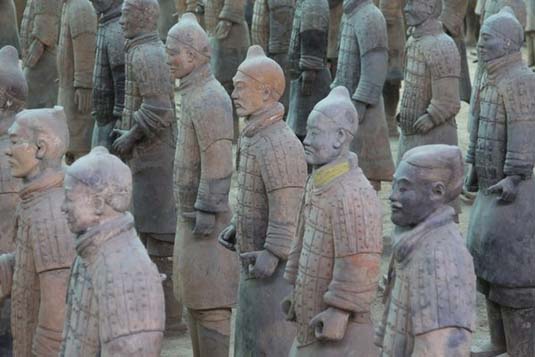 Xian is the heart of China. Outline the map of China and have dots placed on Beijing, Xian, Hunan & Taiwan. The outline will take a shape of the rooster. The dots will be the neck, heart and the two feet respectively! While at it, draw the two arteries of China - The Yellow River and the Yangtze River. Well, Terracotta Warriors made Xian famous. But then there's more to Xian than the mighty army. Flying time from Beijing to Xian is about 90 minutes. With a population of over 7 million, Xian is the Capital city of Shaanxi Province. China has 34 Provinces. And off the 6 ancient capitals of China, Xian is the foremost. The city has been witness to 13 dynasties over its development of 3100 years. Today, apart from tourism, Xian is a major science and technology centre, it is home to the garment industry and is also a major educational hub. The city has over 100 colleges & universities guiding over 800,000 students. While driving from the airport (my English speaking guide, Allen Guo, was in control), I could see vast amount of barren land dotted with mounds. These were the tombs. 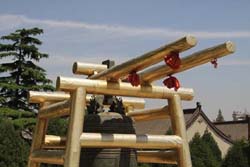 The area,
over centuries, became the imperial burial grounds of the Han Dynasty. And since, treasure was buried along with the dead, local farmers became professional diggers (thieves, put it simply) hunting for buried treasure. One can also take a comfortable express bus from the airport to the city centre for RMB30. Taxi would cost about RMB 100.
The area,
over centuries, became the imperial burial grounds of the Han Dynasty. And since, treasure was buried along with the dead, local farmers became professional diggers (thieves, put it simply) hunting for buried treasure. One can also take a comfortable express bus from the airport to the city centre for RMB30. Taxi would cost about RMB 100.
I was hosted at the Bell Tower Hotel. Thanks to my business connections, I was upgraded to a superior room on the upper floor. The window opened directly to the Bell Tower - another famous landmark of Xian. I landed in the afternoon. Finished a business meeting and took the evening easy walking around the neighbourhood. The next morning Allen picked me up at the hotel at 9 AM. We commenced the city tour by visiting the City Wall, then to the Terracotta Warrior Museum and finally the Big Goose Pagoda. Of course, on our way to the Museum we did make a short stop at a terracotta factory and witnessed the making, baking and selling of terracotta warriors and other artifacts. I didn't buy anything. 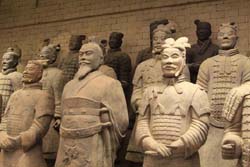 When Zhu Yuanzhang, the first Emperor of the Ming Dynasty (1368-1644), captured Huizhou, a hermit
named Zhu Sheng advised him that since Zhu has come up from an ordinary beginning, he should first build high walls, store abundant food supplies and only then become an emperor else misfortune would befall on him. After the establishment of the Ming dynasty, Zhu Yuanzhang followed the hermit's advice and began to enlarge the wall built initially during the old Tang dynasty (618 -907), creating the modern Xian City Wall. It's the most complete city wall that has survived in China, as well being one of the largest ancient military defensive systems in the world. When Zhu Yuanzhang, the first Emperor of the Ming Dynasty (1368-1644), captured Huizhou, a hermit
named Zhu Sheng advised him that since Zhu has come up from an ordinary beginning, he should first build high walls, store abundant food supplies and only then become an emperor else misfortune would befall on him. After the establishment of the Ming dynasty, Zhu Yuanzhang followed the hermit's advice and began to enlarge the wall built initially during the old Tang dynasty (618 -907), creating the modern Xian City Wall. It's the most complete city wall that has survived in China, as well being one of the largest ancient military defensive systems in the world.
After the extension, the wall now stands 12 meters; 12-14 meters wide at the top and 15-18 meters thick at the base. The perimeter is 14 kms. in length with a deep moat surrounding it. Every 120 meters, there is a rampart which extends out from the main wall. There are 98 ramparts on the wall, which were built to defend against the enemy climbing up the wall. Each rampart has a sentry building, from where the soldiers could protect the entire wall without exposing themselves to the enemy. There are four main gates to the wall. Once up, you have the option, of hiring a bicycle and ride all along the wall. We chose to spend time on one of the towers and in about an hour were ready to proceed towards the warriors. Entry fee to the wall is RMB 40. 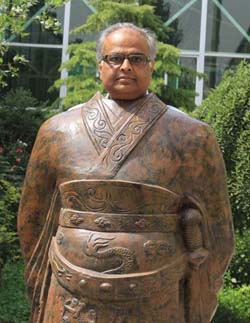 In the eastern suburbs of Xian, about 40 kms. away, stand the Terracotta Warriors. They were unearthed by local farmers while drilling a well as recent as 1974. The Terracotta Warriors are a form of funerary art. The warriors were buried along with the Emperor Qin Shi Huang to protect him in his afterlife. In addition to the warriors, an entire man-made necropolis for the emperor has been excavated. The massive underground complex was constructed to serve as an imperial palace. It comprises several offices, halls and other structures and is surrounded by a wall with gateway entrances. The remains of the craftsmen working in the tomb have also been found within its confines, and it is strongly believed that Qin was so obsessed with what he had created that he ordered the craftsmen to be buried alive to prevent them from divulging information. This was indeed cruel and probably motivated the peasants after the death of the Emperor
to ransack and burn down the mausoleum. Over 8000 figures have been found broken. Archeologists are trying to restore the treasure.
In the eastern suburbs of Xian, about 40 kms. away, stand the Terracotta Warriors. They were unearthed by local farmers while drilling a well as recent as 1974. The Terracotta Warriors are a form of funerary art. The warriors were buried along with the Emperor Qin Shi Huang to protect him in his afterlife. In addition to the warriors, an entire man-made necropolis for the emperor has been excavated. The massive underground complex was constructed to serve as an imperial palace. It comprises several offices, halls and other structures and is surrounded by a wall with gateway entrances. The remains of the craftsmen working in the tomb have also been found within its confines, and it is strongly believed that Qin was so obsessed with what he had created that he ordered the craftsmen to be buried alive to prevent them from divulging information. This was indeed cruel and probably motivated the peasants after the death of the Emperor
to ransack and burn down the mausoleum. Over 8000 figures have been found broken. Archeologists are trying to restore the treasure.
The Terracotta Warriors are a bit bigger than life size. This was done with the hope that bigger would mean stronger and hence they would do a good job in protecting the Emperor. Comparatively, the horses were shorter but were of real size. They were Mongolian horses - short but strong. The hairstyle of the warriors was according to the ranks. General had a double knot; Senior Officials had a square knot; Infantry had 1 knot tilted to the right; Archers had 1 knot tilted to the left (making it easy for them to remove the arrows) and Horsemen had flat hair. Entrance to the Terracotta Warrior Museum is RMB 90. 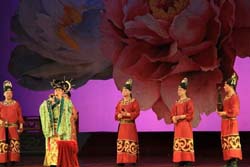 From the museum we left for the pagoda which is within Xian city. The original pagoda was built during the reign of Emperor Gaozong of Tang (649-683), then standing at a height of 54 meters. However, this construction of rammed earth with a stone exterior facade eventually collapsed five decades later. Thereafter, the ruling Empress Wu Zetian had the pagoda rebuilt and added five new stories
by the year 704 AD. However, a massive earthquake in 1556 heavily damaged the pagoda and reduced it by three stories, to its current height of seven stories. The entire structure leans very perceptibly (several degrees) to the west. Drawing of water has disturbed the soil condition thus affecting the pagoda. The site has great importance because of the fact that the monk Xuanzang translated (Sanskrit to Chinese) Buddhist scriptures (which were brought from India). Thus began the rapid spread of Buddhism in China. Entrance to Pagoda is RMB 35.
From the museum we left for the pagoda which is within Xian city. The original pagoda was built during the reign of Emperor Gaozong of Tang (649-683), then standing at a height of 54 meters. However, this construction of rammed earth with a stone exterior facade eventually collapsed five decades later. Thereafter, the ruling Empress Wu Zetian had the pagoda rebuilt and added five new stories
by the year 704 AD. However, a massive earthquake in 1556 heavily damaged the pagoda and reduced it by three stories, to its current height of seven stories. The entire structure leans very perceptibly (several degrees) to the west. Drawing of water has disturbed the soil condition thus affecting the pagoda. The site has great importance because of the fact that the monk Xuanzang translated (Sanskrit to Chinese) Buddhist scriptures (which were brought from India). Thus began the rapid spread of Buddhism in China. Entrance to Pagoda is RMB 35.
It was 4 PM. I decided to head back to the hotel, get some rest and prepare myself for Xian's famous Tang Dynasty show - a Chinese opera with an option of having a pre-show dumpling dinner. RMB 200 for the show. Add RMB 98 for the dumpling feast. 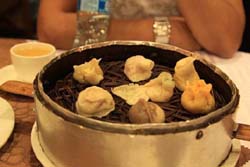 The rituals of bringing in course after course of dumplings began at 6:30 PM. Dumplings are shaped to resemble the filling inside. Duck, chicken, walnut, vegetables, pork, beef, fish… steamed, fried and roasted. All washed down with Chinese tea (unlimited) and with house rice wine, soft drink or water (all limited to a glass; pay for more).
There are some sweet dumplings too. The ritual ends with a bowl of clear soup. At 8 PM the curtains are up for the opera. What followed was 70 minutes of song, dance and music from the era of the Tang Dynasty. Brightly coloured costumes, lavish sets and heavily made up faces kept me glued to the seat. I certainly recommend the opera to first time visitors to Xian.
The rituals of bringing in course after course of dumplings began at 6:30 PM. Dumplings are shaped to resemble the filling inside. Duck, chicken, walnut, vegetables, pork, beef, fish… steamed, fried and roasted. All washed down with Chinese tea (unlimited) and with house rice wine, soft drink or water (all limited to a glass; pay for more).
There are some sweet dumplings too. The ritual ends with a bowl of clear soup. At 8 PM the curtains are up for the opera. What followed was 70 minutes of song, dance and music from the era of the Tang Dynasty. Brightly coloured costumes, lavish sets and heavily made up faces kept me glued to the seat. I certainly recommend the opera to first time visitors to Xian.
I had a meeting in the morning and also some time to walk around the Bell Tower, Drum Tower, Great Mosque and the Muslim Street. All within walking distance of each other. Chinese ancient cities do have their bell and drum towers. As the name suggest, bells and drums are rung every morning and then every two hours thereafter. They work as time keepers to the residents within the wall. Bells and the drums don't sound any more but the charm continues. Entrance to both the towers combined is RMB 36. 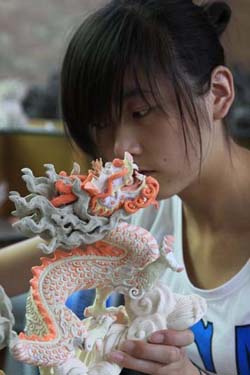 Xian has around 100,000 Muslims. Their history goes back over 1250 years. And so does the period when the Great Mosque was built in 1720 during the Tang Dynasty. The mosque was restored and widened in the Song, Yuan, Ming
& Qing Dynasties. Mosques in China have more of Chinese architecture than Arabic. They don't have dome shapes or the minarets. The mosque in Xian is a tranquil place of worship. Within the premises are 4 courtyards dotted by beautiful gardens and each connected by wooden and stone gates finally leading to the sanctum sanctorum - the place of worship. The hall can seat over 1000 devotees. Also housed are artifacts, furniture, inscriptions from the Ming & Qing Dynasties. Entrance to the Great mosque is RMB 25.
Xian has around 100,000 Muslims. Their history goes back over 1250 years. And so does the period when the Great Mosque was built in 1720 during the Tang Dynasty. The mosque was restored and widened in the Song, Yuan, Ming
& Qing Dynasties. Mosques in China have more of Chinese architecture than Arabic. They don't have dome shapes or the minarets. The mosque in Xian is a tranquil place of worship. Within the premises are 4 courtyards dotted by beautiful gardens and each connected by wooden and stone gates finally leading to the sanctum sanctorum - the place of worship. The hall can seat over 1000 devotees. Also housed are artifacts, furniture, inscriptions from the Ming & Qing Dynasties. Entrance to the Great mosque is RMB 25.
Muslims here speak Chinese of a different dialect. My guide, a native of the province, was unable to follow the dialect. To reach the Great Mosque, we had to walk past the famous Muslim Street. On both sides of the street were curio shops, dry fruit vendors, restaurants and hawkers selling freshly cooked Islamic food. It was fascinating to see rice pudding, bean desserts, steamed dumplings and scores of other delicacies being made. Back to the hotel, I was ready to check out to catch my next flight to Chengdu - for my date with the Giant Pandas. Xian Image Gallery  Photo viewer Photo viewer
|
|
|
Home |
Charity |
Feedback
Privacy Policy | Terms of Usage © YoGoYo.com. All rights reserved. |


































